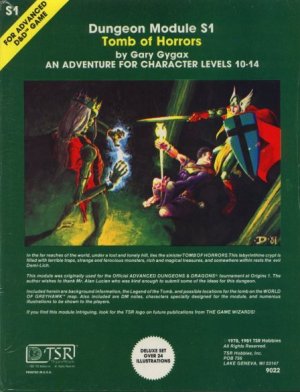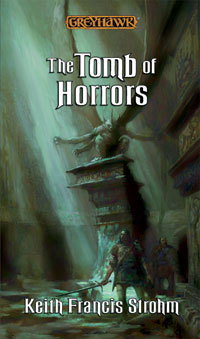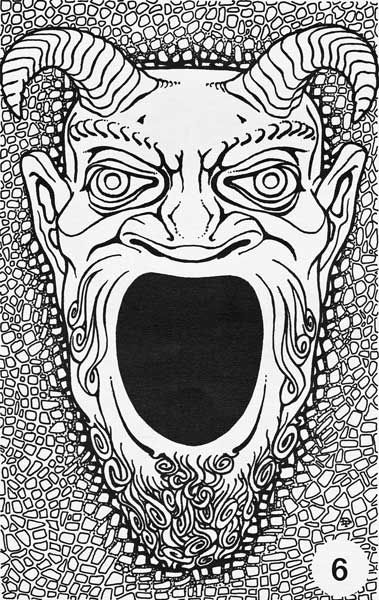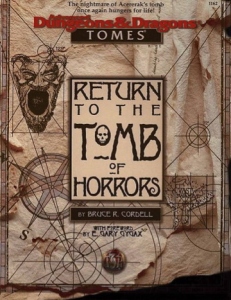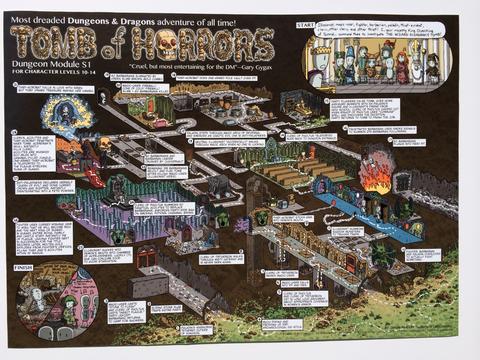(NOTE: Updated the post to include one additional Tomb-related adventure, which I completely forgot about while first writing!)
Part of this feeling on my part is certainly nostalgia, but there really isn’t anything quite like the original Advanced Dungeons & Dragons and its associated published adventure modules. Recently on twitter, I’ve been reminiscing about “Old School Dungeons & Dragons” and discussing some of the classics of D&D and AD&D.
However, there are some adventures that deserve more than a handful of tweets to discuss. One of these, and one of the greatest of all time is the Tomb of Horrors, a 1981 adventure that was the first official “deathtrap dungeon,” designed solely to torment, challenge, and exterminate the player characters. It is incredible for a number of ways, and I thought I would take a little time to talk about why it is so great, and a bit of its legacy!
Originally, I wasn’t planning on writing an ode to the original Tomb of Horrors module. I was going to blog about a novelization of it that was written in 2002 by Keith Francis Strohm. It was one of seven novel versions of classic adventures put out by Wizards of the Coast a few years after they acquired the rights to Dungeons & Dragons from founding publisher TSR.
We’ll talk about the book in the course of this post. The novel is… okay, but in my opinion rather misses the whole point of the Tomb of Horrors, which is what got me thinking: what makes the original module so special and memorable that it not only inspired this novel, but a number of other products (that we’ll also talk about momentarily)?
It’s worth going to the words of the author Gary Gygax himself to begin. The Tomb of Horrors began as an adventure conceived by Gygax to challenge his own gaming group. As he recalled in 1998,
There were several very expert players in my campaign, and this was meant as yet another challenge to their skill — and the persistence of their theretofore-invincible characters.
Rob Kuntz’s character Robilar and Ernie Gygax’s character Tenser actually managed to achieve victory in their respective quests, but this was not representative of what would happen to the thousands of later adventurers who would venture into the tomb. With further developments, Gygax wrote up the Tomb of Horrors as a tournament module for the 1975 Origins I convention in Baltimore, Maryland, and it made it into print at TSR in 1978, one of the first adventure modules published; the very first were the Against the Giants series G1-G3. But Gygax also had a specific personal use¹ for the tomb in other situations:
Before I put it into manuscript form for publication, I carried the scenario around with me in my briefcase, so as to be ready for those fans who boasted of having mighty PCs able to best any challenge offered by the AD&D game. After an hour or so of time spent within the weird labyrinth of Acererak’s final “resting place,” the players whose characters were survivors typically remembered suddenly that they had pressing engagements elsewhere. Clutching their precious character sheets, they fled the table.
The Tomb of Horrors was therefore conceived of as a humbling experience for players, a Memento mori in game form: “remember that you, too, will die.”

Gravestone inscription in Edinburgh, St. Cuthbert’s Churchyard. Via Wikipedia.
This, I believe, is key to understanding the long-lasting appeal of the Tomb of Horrors, but before I say more, let me describe the tomb. From the module itself:
Somewhere under a lost and lonely hill of grim and foreboding aspect lies a labyrinthine crypt. It is filled with terrible traps and not a few strange and ferocious monsters to slay the unwary. It is filled with rich treasures both precious and magical, but in addition to the aforementioned guardians, there is said to be a demi-lich who still wards his final haunt.
This demi-lich is named Acererak, a once powerful wizard who transformed himself into an undead lich of even greater magical power. But Acererak eventually transcended physical form altogether, becoming a “demi-lich,” and departed the prime material plane for dimensions and goals unknown and unfathomable. The tomb he left behind is designed to kill, torment and mock any who are so foolish as to disturb his last physical resting place. Those who fly above the rectangular tomb mound will get a taste of this mockery, as an original illustration shows.
And the tomb is filled with truly deadly and devious traps, many of which are instant kills for careless adventurers. There are also very few monsters to fight: this adds to the sense of helplessness of the characters, because their (likely) usual strategy of overpowering their enemy simply will not work.
If we put the pieces together, the Tomb of Horrors is a dark, abandoned tomb filled with the constant threat of unknown danger.
To me, it is a haunted house. And the Tomb of Horrors is perhaps the very first published Dungeons & Dragons horror story. This is, I believe, the source of its longevity in the gaming world: almost no adventure, before or since, has come close to matching that feeling of dread and infamy that comes with exploring the Tomb.
It should be noted that the Tomb of Horrors isn’t the first haunted house D&D adventure: that title goes to another classic, Tegel Manor, published in 1977 by Judges Guild. The distinction I make with the Tomb is that Tegel Manor is basically a conventional (but very fun) dungeon crawl that happens to be set in a haunted house; it does not have the same “doom around every corner” feeling of the Tomb and thus doesn’t feel like an actual horror story.
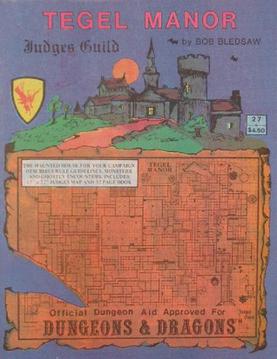
The cover of Tegel Manor. Note the small version of the insanely huge map on the cover! Judges Guild did incredible maps.
The creepy atmosphere of the Tomb of Horrors was enhanced fortuitously by the addition of visual aids to show the appearance of a number of important rooms and features. These images were originally added because there were multiple dungeon masters running the module for tournament play at the same time, and it was important that they all agreed on the details of certain scenes. The original images (which appear in the really amazing 2018 Art & Arcana book on the history of D&D) were upgraded and included in the printed module, and the rest is history.

The entry hall to the Tomb of Horrors. “The scenes painted show fields with kine grazing, a copse with several wolves in the background, slaves (human, orc, elven, and strange human-animal mixture — pig-human, ape-human, and dog-human) going about various tasks.”
One particularly infamous sculpture at the end of the entrance hall would become the symbol not only of the Tomb of Horrors, but of Acererak himself.
These module illustrations, by Dave Sutherland and Dave Trampier, create an amazing atmosphere for the Tomb: it feels like an actual tomb, filled with the relics, art and twisted obsessions of its departed master. It is worth noting that Gygax was originally inspired to create the Tomb of Horrors by the urging of Alan Lucien, who had written part of an Egyptian-themed tomb that Gygax then expanded upon. Looking at the art of the Tomb of Horrors entryway, the Egyptian tomb influence is pretty obvious.
The climax of the adventure, assuming the players ever find the true vault of Acererak, is a deadly and soul-sucking battle with the remaining vestige of the demi-lich on the material plane — a new class of undead monster created just for the tomb. Anyone who survives, and wasn’t turned to ash, will reap great rewards.
Though the module first appeared in 1978, it refused to die, much like Acererak himself. The original version had a two-tone colored cover, which was replaced by the full color cover most people are familiar with in 1981. The Tomb of Horrors was the first of four S-series modules, and the quartet was published together in a single volume in 1987 as Realms of Horror.

1987’s Realms of Horror. Note the jeweled skull on the cover, which is the demi-lich form of Acererak.
The demi-lich monster class introduced in the Tomb was also added as a regular game monster, making an appearance in the 1983 Monster Manual II.

But even this was not enough Tomb for many players! In 1998, TSR published Return to the Tomb of Horrors, by Bruce Cordell, one of a series of nostalgia-based sequels to classic adventures. This mega-campaign, which first appeared in box form, elaborates on the origins of Acererak, and reveals that his tomb was always just the first part of a more elaborate plan to trap the most potent souls. In the adventure, the players will go from the Tomb to other dimensions to a showdown with Acererak himself/itself.
I have to admit that the first time I read this short summary of the plot of Return, I was underwhelmed. As a horror story, the original Tomb is nearly perfect: the mysterious origins and motivations of the demi-lich add to the feeling of dread, and anyone who is a fan of horror knows that too much explanation can ruin the atmosphere.
But last week I finally, after years of delay, purchased and read through Return, and I can say: it is really, really excellent. It is a sequel that truly does justice to the original. Without giving too many spoilers, let me summarize the path the adventurers take. After encountering undead in a strange mist enveloping a city, they seek out the source. They learn of a wizard who might have information, and soon discover that he was a part of a doomed adventuring party that explored the original Tomb many years past. After learning more details from the remains of the wizard’s former adventuring party, the player characters (PCs) head to the Tomb itself.
They find that it is no longer isolated. Due to a surge of magical power around the Tomb, evil necromancers have been drawn to it, and have created a “Skull City” around it. The PCs must infiltrate this city and get to the temple at its center, built over the original Tomb entrance. From there, they must survive all the dangers of the Tomb in order to pass to the next testing ground of Acererak, a cursed, empty and ruined city that now lies on the boundary of the Negative Energy Plane. If they are able to solve the deadly puzzles there — and escape an incredibly dangerous horror — they can travel to the Fortress of Conclusion, Acererak’s actual lair and a maze filled with traps just as deadly as the Tomb. At the end, they must try and stop the demi-lich from accomplishing his evil plans — though the terrible price to do so may be more than any is willing to pay.
The atmosphere of Return is comparable to the original Tomb, and it includes a large number of illustrations to enhance the mood. Both the backstory of Acererak as well as the story of the missing wizard have incredible payoffs, and the Fortress of Completion is filled with traps worthy of Acererak’s name. As Gygax himself commented¹ in his introduction to the new adventure:
Here is a very different, multi-environment adventure of great scope. It offers more by far than did the old Tomb of Horrors, and it is more deadly, too. If you must seek to relive the glories of eld, then even your hands will discover that the new funerary site has different and more hair-raising challenges, sufficiently so as to make it worth more than the price of admission.
As a delightful touch, Return includes the 1981 Tomb of Horrors module in its printing, so when players must go to the Tomb, they are actually playing through the original Tomb! They get hints of its secrets from the journal of the missing wizard of the past exploration, which is a nice touch: they get an idea of what to expect inside the Tomb, not enough to avoid danger but enough to make them dread what is to come.
By the way, the price for failure is also steep: if the PCs fail to stop Acererak’s plans, the outcome is a truly chilling one with multiverse-spanning implications.
But even Return to the Tomb of Horrors would not mark the end of Acererak’s mischief! In 2010, Wizards of the Coast (the new owners of the D&D line) released a new Tomb of Horrors for the 4th edition rules, which evidently serves as a sequel to Return. I have not yet read this version, and have not found a good summary online, so I shall not say much about it here.
Fifth edition Dungeons & Dragons introduced its own iteration of Acererak’s evil with Tomb of Annihilation, published in 2017. Though the original Tomb and Return were set in Gygax’s original Greyhawk setting, Annihilation moves the action to the Forgotten Realms campaign setting, implicitly acknowledging the demi-lich’s world-spanning power.
The Realms have been afflicted with a mysterious Death Curse, which prevents anyone from being raised from the dead by magical means and is slowly killing anyone who has been raised from the dead in the past. The PCs are hired by one of these dying victims to seek out the source of the Curse, which leads them to the largely untamed jungle lands of Chult. Their quest eventually leads them to the Forbidden City of Omu, now in ruins, and to the Tomb of the Nine Gods within it. Acererak has repurposed the Tomb for his own plan: to claim enough souls with the help of a diabolical magical machine in order to birth a new god of death and unleash it upon the realms. The PCs must search Omu in order to unlock the Tomb and then travel through six dungeon levels in order to foil Acererak’s plans.
The release of Tomb of Annihilation was a major event for Wizards of the Coast, and it is an impressive, well put together adventure that will challenge the cleverest players. Personally, I did not find that it matched the same horror of the original Tomb of Horrors or Return, but it is definitely an epic story and a fun one.
Although sequels were appearing regularly, the original Tomb of Horrors also refused to stay quiet. In 2005, Wizards of the Coast released on online version of the classic Tomb, updated to the 3.5 edition of the rules. In 2013, Wizards of the Coast released multiple special editions of first and second edition AD&D books; among the products released was Dungeons of Dread, which included modules S1-4 and featured a now very familiar demon head on the cover.
And, in 2017, Wizards included the Tomb of Horrors, updated to 5th edition rules, in their compendium of classic dungeons, Tales From the Yawning Portal.
One really can’t keep a bad lich down, it seems! I imagine that Acererak will, like the best comic book villains, keep returning to unlife as the years pass to torment a new generation of unwary adventurers.
One other amazing Tomb product is worth mentioning here. Around the time of the AD&D reprints, Wizards of the Coast commissioned my twitter friend Jason Thompson (@mockman) to make humorous cartoon walkthrough maps of classic D&D adventures, including, of course, the Tomb of Horrors.
I only include a preview of the map here, to give you a feel for it; the full map and those of other adventures can be viewed, and purchased, on Jason’s website. I have a printed and framed copy of the Tomb of Horrors in my upstairs hallway; it is genuinely funny and a treat to anyone who is familiar with classic AD&D! (I also have another piece of Jason’s art hanging in my home — check out all his work!)
So now let’s go back, at long last, to the 2002 novelization of The Tomb of Horrors. The novel features a fallen paladin named Kaerion Whitehart who now ekes out a living as a mercenary with an elven ranger Gerwyth. Their luck seems to change when they are approached by the nobility of the country of Nyrond to undertake a difficult quest: to plunder the riches of Acererak’s tomb for Nyrond, in order for the nation to reclaim its former glory. They agree to the mission, and join a band of adventurers for the long journey through swampland to the Tomb itself. But they are unaware, at first, that another group also seeks the Tomb: cultists of the dread god Tharizdun believe that Acererak’s abode holds the secret to awakening their deity. So begins a cat-and-mouse expedition across dangerous wilderness, with the conflict coming to a head in the presence of the demi-lich Acererak himself.
The novel is reasonably well-written, but suffers in my opinion from one great flaw: only a third of it is set in the Tomb of Horrors itself! The first two thirds of the book focuses on the journey to the Tomb, the machinations of the cultists, and the struggles of Kaerion to reclaim his lost faith. But, as I have argued, The Tomb of Horrors is a haunted house story, and in every such story the haunted house itself is the main character! In the novel, the Tomb feels mostly like a series of passive tricks and traps, and not an active, haunting, and brooding presence constantly seeking to destroy the explorers. That is, in the end, the appeal of the Tomb of Horrors to me: even though it is almost completely empty of monsters, it is filled with sinister purpose, and feels alive. (I feel so strongly about this that I am tempted to try my own hand at a novelization of the module, but that will be some time in the distant future, if ever.)
I am still haunted by the Tomb of Horrors myself. Every now and again I have to go back and read the module again, and wander its halls of death and despair to seek new thrills and hints of great and sinister powers working behind the fabric of our reality.
**************************************************************
¹ Interview excerpts taken from Gary Gygax’s introduction to Return to the Tomb of Horrors.
Postscript: If you’ve ever wanted to see the Tomb of Horrors lovingly rendered in 3D, it’s been done.
Post-postscript: Return to the Tomb of Horrors can be purchased at DriveThruRPG in pdf form, print form, or both! It is reprinted as a single bound volume, not a boxed set as the original, but the quality is excellent.

